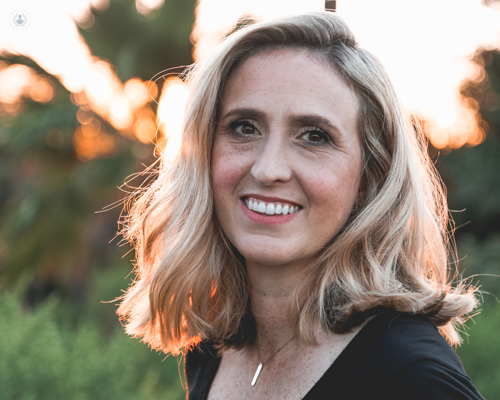Empower yourself: The basics of Breast Health Awareness
Escrito por:Breast cancer awareness and early detection play pivotal roles in improving outcomes. One of the essential tools in this fight is the breast self-exam (BSE). Understanding how to perform a BSE, what to look for and when to seek professional help can empower you in your health journey.
Leading general practitioner who specialises in women's health Dr Alisha Esmail guides us through what's involved in breast cancer awareness in this informative article.

How should you perform a Breast Self-Exam?
Regular BSEs should be a routine practice for all women (and men)! Try to aim for at least once a month. Here’s a simple 4 step guide:
- Visual Examination: Begin by standing in front of a mirror with your hands on your hips. Observe the breasts and nipples for any changes in size, shape, or skin texture. On the skin, specifically look for dimpling, puckering, or redness.
- Raise Your Arms: Raise your arms overhead and examine your breasts in the mirror for any changes in contour or swelling.
- Lying down: Lie down if you’re able, and cup your fingers together on the opposite hand to feel each breast. When it comes to palpating, there are a few techniques in the playbook! You've got the spiralling ‘wagon wheel’ method, the vertical up-and-down method, and the concentric circle method—all tried and tested ways to cover the field so try all to see which works best for you. Take care not to miss the outer breast, nipple and underarm on each side.
- Nipple Check: Gently squeeze the nipple and check for any discharge.
Top tip 1: If you struggle to see changes, comparing both breasts for any new asymmetry might help!
What should you be looking for?
During a BSE, be attentive to the following signs:
- Lumps or thickening in or near the breast or underarms.
- Changes in breast size or shape.
- Dimpling or puckering of the skin.
- Nipple changes e.g. inversion, discharge, or redness.
- Skin redness or scaliness.
Top tip 2: If you menstruate, try to avoid doing a BSE around a period, as breasts are expected to be naturally lumpier around then.
When should you seek help?
If you notice any of the above changes during a self-exam or experience persistent breast changes, it's crucial to seek medical advice promptly from a GP or a Specialist. While most breast changes aren't cause for alarm, getting them checked out early is key to your peace of mind and for ruling out any concerns!
Top tip 3: Hot showers or baths can be an opportune time to do a quick BSE!
What else could breast changes mean?
Statistics from the World Health Organization reveal that only 1 in 10 breast lumps are diagnosed as cancerous. Frequently, most breast changes stem from benign and often very treatable conditions! These can include cysts (fluid-filled bubbles), fibroadenomas (non-cancerous growths), and fat necrosis (tissue injury post-trauma). For those breastfeeding, infections like mastitis and blocked milk ducts are common culprits.
Top tip 4: Regardless of gender, BSEs should be part of everyone's routine. Breast cancer does not discriminate, so neither should you!
How important are regular checks?
To give you an idea of how important regular checks are, early pick up of breast cancer when it hasn’t spread beyond the breast, can have a 99 per cent five-year survival rate (American Cancer Society), compared to lower figures if it has spread.
But breast cancer awareness extends beyond self-exams. Regular reviews and potentially mammograms for individuals over 50 or with other risk factors are crucial.
Top tip 5: For breastfeeding mums, consider breastfeeding for up to a year if you’re able, as there is some evidence to show it’s protective (but don’t put undue stress on yourself to do so, as that in itself can reduce supply!)
What are the risk factors and how can I reduce my own risk?
When evaluating your risk of breast cancer, we consider various factors that make up your overall profile, categorizing them as 'modifiable' and 'non-modifiable' risks. 'Modifiable' risks encompass aspects like being overweight (particularly if post-menopausal), a sedentary lifestyle, smoking, excessive alcohol consumption and if you’re taking specific hormones found in some types of contraception and HRT. On the other hand, 'non-modifiable' risks, such as older age, genetic mutations, and family history of breast cancer and certain other cancers, are factors beyond one's control.
Needless to say, focus on maintaining a healthier lifestyle to target those ‘modifiables’ and speak to a Nurse or Doctor if you need support with this!
Top tip 6: Gently starting conversations about breast cancer in your family might reveal insights into your own risk
Can London Gynaecology help?
Book a consultation with one of our experienced GPs or Gynaecologists to discuss your concerns holistically, to have a breast examination and to make a plan together. This may or may not need further investigations or referral.
Remember: Regular breast self-exams, knowing what to watch for, and seeking prompt medical advice are vital for breast cancer awareness and early detection. Be proactive, stay informed, and prioritize your breast health - it could save your life!
Are you concerned about your breast health? Arrange a consultation with Dr Esmail via her Top Doctors profile.


